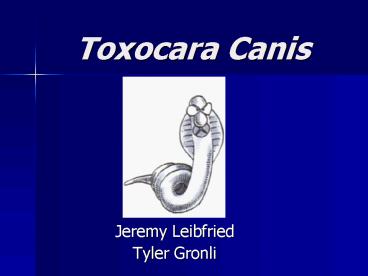Toxocara Canis PowerPoint PPT Presentation
1 / 18
Title: Toxocara Canis
1
Toxocara Canis
- Jeremy Leibfried
- Tyler Gronli
2
Introduction
- Dog Round Worm
- Phylum Nematoda
- Zoonotic Disease
- T. cati is the feline form
3
Infection
- Geographic Range Worldwide
- Definitive Host Dogs
- Intermediate Host None
- Accidental Host Humans and other mammals
- Children more susceptible than adults
4
Infection
- Dogs
- Found in Intestines
- Ingest Egg
- Transplacenta
- Transmammary
- Puppies Born Infected with T. cannis
- Puppies less than 5 weeks
- Humans
- Can be found in liver, lung, brain, heart,
muscle, or eye
5
Morphology
- Eggs
- 85µm x 75µm
- Have thick brown shell
- T. cati eggs look
- identical
6
(No Transcript)
7
Morphology
- Adult Female
- 5 to 18 cm long
- Adult Male
- 4 to 10 cm long
8
Life Cycle
- Eggs must be present in external environment for
2 weeks to bi infective - Ingestion by dog
- Eggs hatch and larvae penetrate the gut wall
- Migrate into various tissues encyst if dog older
than 5 weeks - Younger dogs larvae migrate through lungs,
bronchial tree, esophagus, and move back into the
small intestine
9
Life Cycle
- Older Dogs
- Encysted Stages reactivate during pregnancy
- Infection spread by transplacental and
transmammary routes - Infective eggs spread through lactating bitches
10
Life Cycle
- Accidental Host
- Infected by ingestion of infective eggs
- Eggs hatch and larvae penetrate the intestinal
wall - Carried by Circulatory System to various tissues
- Larvae dont undergo further development but can
cause reactions in tissue (toxocariasis)
11
(No Transcript)
12
Symptoms
- In dogs usually asymptomatic
- Heavy infections can result in death
- In Humans
- Abdominal Pain
- Decreased Appetite
- Restlessness
- Fever
- Hives
- Other symptoms vary with site larvae infection
13
Ocular Larvae Migrations (OLM)
- Caused by larva migration to the retina
- Inflammation
- Scar formation
- Retinal Detachment
- Partial to Full Vision Loss
- 10,000 Infections per year
- 700 permanent vision loss
14
Visceral Larvae Migrations (VLM)
- Caused by movement of worm larvae throughout
various organs of the body - Dependent on organ infected
- Fever
- Coughing
- Asthma
- Pneumonia
- Wheezing
- Hepatosplenmegaly
15
(No Transcript)
16
Diagnonsis
- Dogs
- Fecal Float
- Humans
- Monitor for symptoms
- ELISA
- Anti-Toxocara antigen IgE Level
- CT scans or Ultrasound can allow for visualization
17
Treatment
- Use anti-parasitic drugs in combination with
anti-inflammatory medications - Albendazole
- Preferred Choice
- Mebendazole
- Thiabendazole
- Ocular Larvae Migrations Require Surgery
18
Control Methods
- Treat dogs, especially puppies, regularly for
worms - Good hygiene practices when handling animals
- Dont let children play in
- areas dogs are allowed to
- defecate
- Teach children not
- to eat dirt or soil

